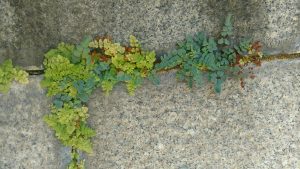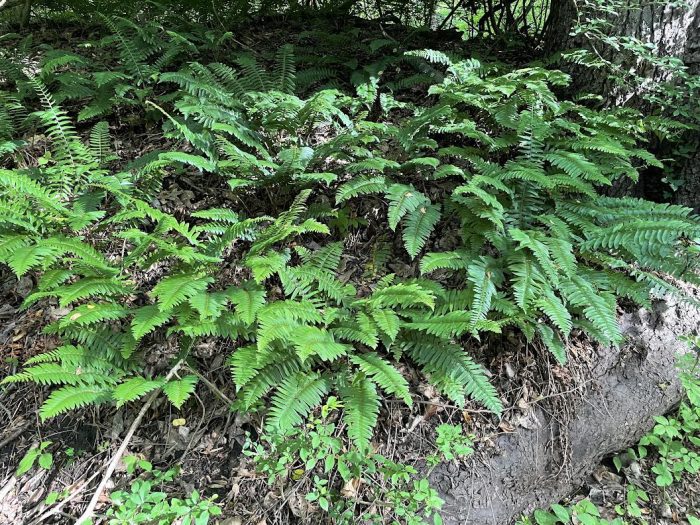By John L. Turner
Throughout the forests, woodlands, and wetlands of Long Island exists a group of plants with great lineage and I do mean GREAT lineage, with a fossil record that goes back approximately 360 million of years, well before the appearance of dinosaurs. In some places in the world, but not Long Island, these species reach tree size. Dozens of examples of this group can be found here, perhaps one or a few in an untouched section of your yard. What group might this be? Ferns and their relatives — the clubmosses and horsetails (the latter two will be the subject of a future article).
Because they aren’t colorful, ferns are often thought of as “background plants” in landscape settings. But that doesn’t mean they aren’t beautiful because many are very much so, given their fragile, graceful, and lacy appearances. Generally you can think of a fern frond as being “undivided, once-divided, twice-divided, or thrice-divided,” the lacier a fern the more “cuts” or divisions it has. (We don’t have any undivided ferns native to Long Island).

Remembering how many times a fern is divided is a convenient way to classify and identify species (it’s how I learned it many decades ago). So a fern like the well-known Christmas Fern, is a “once-divided fern” since its one division creates just a series of leaflets that collectively make up its frond surface. A twice-divided fern, like Bracken Fern, has leaflets like the Christmas Fern but in the Bracken Fern’s case, the leaflets themselves have cuts, creating subleaflets or pinnules. If, in turn, the subleaflets are cut to form even smaller lobes, as in Hayscented Fern, you’re looking at a thrice-divided fern.
Ferns have no flowers — no nectar, pollen, or seeds and depend upon no insects or animals to successfully reproduce. Rather, they depend upon spores and vegetative spread (through rhizomes in most cases but also, as in the case of Walking Fern, an undivided species that doesn’t grow on Long Island, in which the fern tip arches downward to anchor in the soil from which another fern grows, hence the term “walking”).
The tiny, almost microscopic, spores develop within a case known as a sporangia. Often the sporangia are clustered together in what are known as sori or fruit-dots (although this isn’t accurate). The location of the sori can be very helpful, in fact diagnostic, in identifying fern species. With some, such as Sensitive, Cinnamon, and Netted Chain Ferns, the sori are located on a separate stalk, while in others like Grape Ferns they are connected via a stalk to the main frond. Most often though, the sori are located on the underside of the frond leaflets and their shape and location on the leaflet can be diagnostic as to species. A five to seven power hand lens opens up a new world to you while inspecting the many distinctive spore cases produced by our native ferns.
You might reasonably assume that a spore, wafting away from a sporangia upon the slightest breeze, will eventually land in a suitable location, germinate, and develop into a new fern. Your assumption, while most reasonable, would be incorrect as the process is more complicated and this is where the concept of “alternation of generations” comes in. The spore does germinate and develop, but not directly into a new fern. Rather, it grows into a prothallus, a small structure shaped like a Valentine’s Day heart. The prothallus is the “gametophyte” stage because the prothallus contains the gametes or sex cells (sperm and egg) On one part of the “heart” is the antheridia, where the sperm come from, and nearby is the archegonia, which produces the egg. In optimal conditions, that is, when the prothallus is wet, the sperm travels the short distance to the egg. Upon germination a new spore-producing fern (the sporophyte stage) develops. The sporophyte is the fern stage that is before your eyes to identify and enjoy. So we have sporophyte-gametophyte-sporophyte-gametophyte, ad infinitum.
As mentioned, some ferns spread vegetatively through the growth of underground horizontally oriented rhizomes from which new fronds grow in a perpendicular fashion, emerging from the surface of the soil. Bracken Fern, the common fern species of the drier upland habitats in the Pine Barrens, is an excellent example of a fern that spreads through rhizomes. In some places bracken fern stands can cover as much as an acre or more.
Long Island is home to several dozen fern species, present in most habitats occurring here. Freshwater and forest habitats are especially well represented with ferns; however, none occur in salt marshes or on beach dunes. Let’s look at some!
The previously mentioned Christmas Fern is a common and widespread species growing throughout Long Island’s woodlands. It is often noted the species received its name from the similarity of a leaflet to a Christmas stocking hanging from a fireplace mantle. A competing explanation is that this fern species is one of the few plants still green through the winter, standing out around Christmas time.
Similar looking to Christmas Fern but smaller is the Common Polypody, so named due to the resemblance of the leaflets to lobed feet (think pody-podiatrist). This fern is uncommon here, growing on steep slopes and large boulders. This species was a favorite of Henry David Thoreau who on several occasions remarked about the “cheerful communities” of polypody growing on rocks in New England.
Sensitive Fern grows in more sunlit locations and is easy to identify, with a “once-divided” look. As mentioned above, the sporangia are on separate stalks growing from the rootstock. Come the fall and frost, Sensitive Fern quickly dies back, hence its name.
Cinnamon Fern is an abundant fern growing in moist woodlands and wooded swamps. It is quite distinctive with a beautiful growth form in which several sterile fronds radiate from a central rootstock with the spore-producing fronds coming up through the middle. The sterile fronds appear as unfurling fiddleheads (there are no species of ferns known as fiddleheads per se; a fiddlehead is a growth stage of some ferns in which the emerging frond at first is curled like the head of a fiddle; in some species, the fiddleheads are edible). They are coated in a cinnamon “wool” — giving rise to the common name — which is reportedly used by hummingbirds and a few songbirds as nest lining material.
Bracken Fern is, as mentioned earlier, locally common to abundant in the Pine Barrens, forming an extensive thigh-high layer, unmistakable due to its triangular growth form. Bracken Fern is one of the more widespread species of ferns, found in many other places in the world including Japan and Asia. While it spreads mostly vegetatively, it also produces spores located on the rolled margins of the leaflets. It was once harvested for food but this came to an end when the species was determined to be carcinogenic.
New York Fern is another common woodland fern. It is distinguished by the tapered nature of both the top and bottom of the frond. Supposedly, a New England botanist thought this tapered growth form reminded him of New York socialites who “burned their candles at both ends” and the name New York Fern stuck.
Most native ferns here are adapted to acidic soils and as a result we don’t have many ferns that prefer more basic, calcarious soils found in limestone regions. On a birding field trip six years ago to Fort Totten in northern Queens Andy Greller (a very fine botanist, naturalist, retired Biology Professor from Queens College, and all around good guy) and I found some Purple Cliffbrake and Blunt-lobed Cliff Fern growing in the mortar seams holding together the large stones of the fort. The mortar provided the right conditions for these limestone loving ferns to thrive.
There are many other ferns awaiting your discovery — Royal and Interrupted Ferns both of which are related to Cinnamon Fern (the latter so named because the leaflets on the sterile frond are “interrupted” by the fertile leaflets in the middle of the frond), the Chain Ferns, the Grape Ferns, the hard to identify but lacy Wood Ferns, Lady, Marsh and Hay-scented Ferns, the distinctive looking Ebony Spleenwort, and a few others.
Right now these species await your visit and if you go exploring, don’t forget to bring a hand lens!
A resident of Setauket, John Turner is conservation chair of the Four Harbors Audubon Society, author of “Exploring the Other Island: A Seasonal Nature Guide to Long Island” and president of Alula Birding & Natural History Tours.





